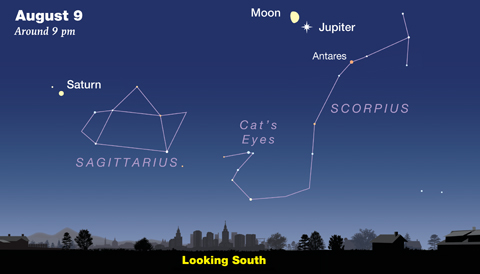Download August's Sky Tour astronomy podcast for tips on observing the Perseid meteor shower and the key planets, stars, and constellations in the evening skies of summer.
LISTEN HERE:
Podcast: Play in new window | Download
Subscribe: Apple Podcasts | Google Podcasts | Spotify | Email | RSS | More
This month's Sky Tour starts with a recap of lunar phases, highlights the always colorful Perseid meteor shower, and then points the way to Jupiter and Saturn before exploring the Teapot of Sagittarius, Scorpius, Boötes, and other constellations and key stars of the mid-summer sky.
The words Moon and month derive from the same Old English roots. Still, it’s just a coincidence that the Moon’s phases have been closely in sync with the calendar recently. New Moons come just as August begins and ends, with first quarter on the 7th and a fully lit disk on the 15th. In Native American lore, the latter was often called the Full Sturgeon Moon, but some tribes knew it as the Full Red Moon, due the color it takes on when rising after a hazy sunset.
As you'll hear in the podcast, this month features a perennial favorite: the Perseid meteor shower. The Perseids have a fairly sharp peak, which this year is forecast for about 9 p.m. Eastern Daylight Time on Monday, August 12th. So the best time to look is late that evening and in the wee hours of Tuesday, the 13th. Ordinarily you might see at least one meteor per minute in the hours after midnight. Unfortunately, light from a nearly full Moon will spoil the show.
But don't worry — there's plenty to see elsewhere in the evening sky. You’ll find Jupiter almost due south at nightfall, roughly a third of the way from the horizon to overhead. Using Jupiter as a guide, you’ll have no trouble finding Saturn. It’s over to Jupiter's left, or east, by about two fists.

Sky & Telescope
Jupiter is near Scorpius, the Scorpion, and Saturn is near the Teapot asterism of Sagittarius. These two constellations host some of the most amazing sights in the summertime Milky Way. If you can view from a dark, moonless sky, looks for the "steam" of dense star clouds drifting upward from the Teapot's spout. This is the direction toward the center of our galaxy.
To find out where and when to spot all these sky sights and many more, play or download this month's Sky Tour episode.
 2
2
Comments
Neil-Aubrey
August 1, 2019 at 9:16 pm
Always disappointed that much of the content is Northern Hemisphere biased. A little editorial change would make it more relevant to us on the South.
You must be logged in to post a comment.
J. Kelly BeattyPost Author
August 5, 2019 at 4:09 pm
hi, Neil . . . I'm sensitive to your plight, but I don't see an easy way around this — short of recording a second podcast for the Southern Hemisphere. even here in the U.S. describing the altitude of, say, Scorpius is tricky because it varies so much with latitude.
You must be logged in to post a comment.
You must be logged in to post a comment.